Interactive Water Cycle Diagram for Kids (Intermediate)
The water cycle describes how Earth's water is not only always changing forms, between liquid (rain), solid (ice), and gas (vapor), but also moving on, above, and in the Earth. This process is always happening everywhere.
![]() Back to the water cycle on the USGS Water Science School.
Back to the water cycle on the USGS Water Science School.
The interactive water cycle diagram is being updated. We are looking to talk to educators to understand how we can improve the diagram. Please email us at water-science-school@usgs.gov if you'd be willing to share an hour of your time to help us.

Atmosphere
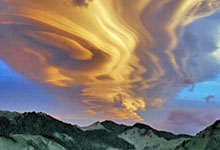 The atmosphere is all the air from the bottom of an ant's leg up to where there is no more air - many miles in the sky. The air outside may look invisible, but it is full of molecules, including water molecules (water vapor).
The atmosphere is all the air from the bottom of an ant's leg up to where there is no more air - many miles in the sky. The air outside may look invisible, but it is full of molecules, including water molecules (water vapor).
The water in the air rises up high into the sky and becomes clouds, which float away looking for a picnic to rain on. The atmosphere is the superhighway in the sky that moves water everywhere over the Earth.
Condensation
 All air contains water molecules in the form of water vapor, which is an invisible gas. Take a breath and breathe on a glass pane—you see liquid water magically form. This process is "condensation".
All air contains water molecules in the form of water vapor, which is an invisible gas. Take a breath and breathe on a glass pane—you see liquid water magically form. This process is "condensation".
Clouds are created in the same way. Why? Condensation happens because of temperature changes. As warmer air (containing water vapor, remember?) floats up into the sky, where it is cold, condensation happens and tiny liquid water particles form ... the clouds. Colder air cannot keep the water vapor as a gas as easily as warm air.
Evaporation
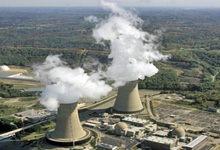 For the water cycle to work, water has to get from the Earth's surface back up into the skies so it can rain back down and ruin your parade. Evaporation changes liquid and frozen water into water-vapor gas, which then floats up into the skies to become clouds.
For the water cycle to work, water has to get from the Earth's surface back up into the skies so it can rain back down and ruin your parade. Evaporation changes liquid and frozen water into water-vapor gas, which then floats up into the skies to become clouds.
As usual, you can thank the sun for making evaporation work. The sun's energy breaks the bonds that hold liquid water's molecules together and turns them into water vapor gas. Thus, it makes sense that water evaporates more easily in hot conditions, such as in the desert, rather than outside on a cloudy winter day.
Fog
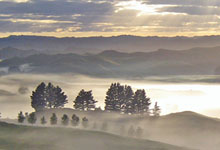 Fog is just a cloud that happens to be hanging around on the Earth's surface.
Fog is just a cloud that happens to be hanging around on the Earth's surface.
Fog contains very tiny liquid water particles, like a cloud, and floats, like a cloud. Actually, fog IS a cloud, but one that swirls around your feet instead of high in the sky. Fog forms when air containing invisible water vapor encounters cooler temperatures (here, next to the ground) and the water vapor condenses out into liquid water—the cloud.
In this picture, as the day warms the air next to the ground will warm, too, and the fog particles will again evaporate back into invisible water vapor.
Groundwater flow
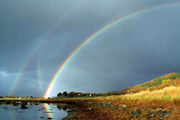 If you pour a glass of water onto the ground it usually sinks right in (infiltration), so you can imagine how much water sinks into the ground during a major storm (Find out here). Here in Atlanta, Ga, USA it rains about 50 inches/year. Over a 100 square mile (10 miles by 10 miles) area that means 87,000 billion gallons of water falls, with much of it soaking into the ground to recharge groundwater.
If you pour a glass of water onto the ground it usually sinks right in (infiltration), so you can imagine how much water sinks into the ground during a major storm (Find out here). Here in Atlanta, Ga, USA it rains about 50 inches/year. Over a 100 square mile (10 miles by 10 miles) area that means 87,000 billion gallons of water falls, with much of it soaking into the ground to recharge groundwater.
Yes, water below your feet is moving all the time, but, no, if you have heard there are rivers flowing below ground, that is not true.
Groundwater flow. Relate to recharge a battery.
Groundwater
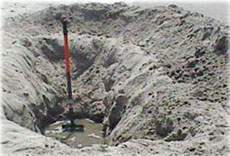 When you are standing on the ground, you're not only standing on dirt, but on water–a lot of water. The dirt and rock below your feet contains lots of spaces and cracks, and water can exist in these open spaces. In fact, over 20 times the amount of water in all of Earth's rivers and lakes is in the ground.
When you are standing on the ground, you're not only standing on dirt, but on water–a lot of water. The dirt and rock below your feet contains lots of spaces and cracks, and water can exist in these open spaces. In fact, over 20 times the amount of water in all of Earth's rivers and lakes is in the ground.
When you pour a glass of water on your yard, the water sinks (infiltrates) into the ground and gets back into being a vital part of the global water cycle.
Of course, the rock underground is different all over the world, so how much and where water occurs of water underground is different everywhere. Deep in the ground, the rock becomes very hard and solid (no open spaces to hold water), and it also gets very hot, so no liquid water is found deep in the Earth.
Ice and snow
Ice and glaciers are part of the water cycle, even though the water moving in them changes very slowly. The amount of ice on the Earth goes up and down as the world's climate cools and warms over thousands of years.
Lucky for us we're now in a warmer phase of the Earth's history, but the last Ice Age was only 18,000 years ago. At that time, ice covered the northern part of North America.
Ice and glaciers are still around today, as this picture shows. In fact, most of the world's freshwater, about 68 percent, is locked up in ice, snow, and glaciers.
Oceans
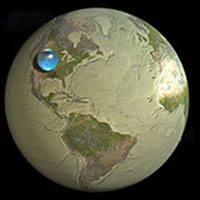 If you look at this picture (or click on it for a larger version) you see that "tiny" blue ball sitting in the middle of the United States—if all the water on, in, and above the Earth was collected in one big ball, this is the size it would be.
If you look at this picture (or click on it for a larger version) you see that "tiny" blue ball sitting in the middle of the United States—if all the water on, in, and above the Earth was collected in one big ball, this is the size it would be.
The oceans are, by far, the largest reservoir of water on earth—over 96% of all of Earth's water exists in the oceans.
Oceans are important to the water cycle because almost all the water that evaporates from liquid to water vapor (which forms clouds) comes from the oceans.
Plant uptake
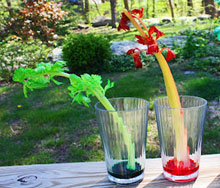 Every tree, grass blade, and plant around you is performing a gravity-defying wonder: it is moving water, against the force of gravity, upwards from the ground into its roots, trunk, branches, and leaves.
Every tree, grass blade, and plant around you is performing a gravity-defying wonder: it is moving water, against the force of gravity, upwards from the ground into its roots, trunk, branches, and leaves.
Plants depend on water in the ground for their needs. Even when you sprinkle your garden with water to give it a drink, the plants want the water that soaks into the ground next to them, not from the water that lands on their leaves. Roots in the ground pull the water up into the plant to keep it healthy.
Precipitation

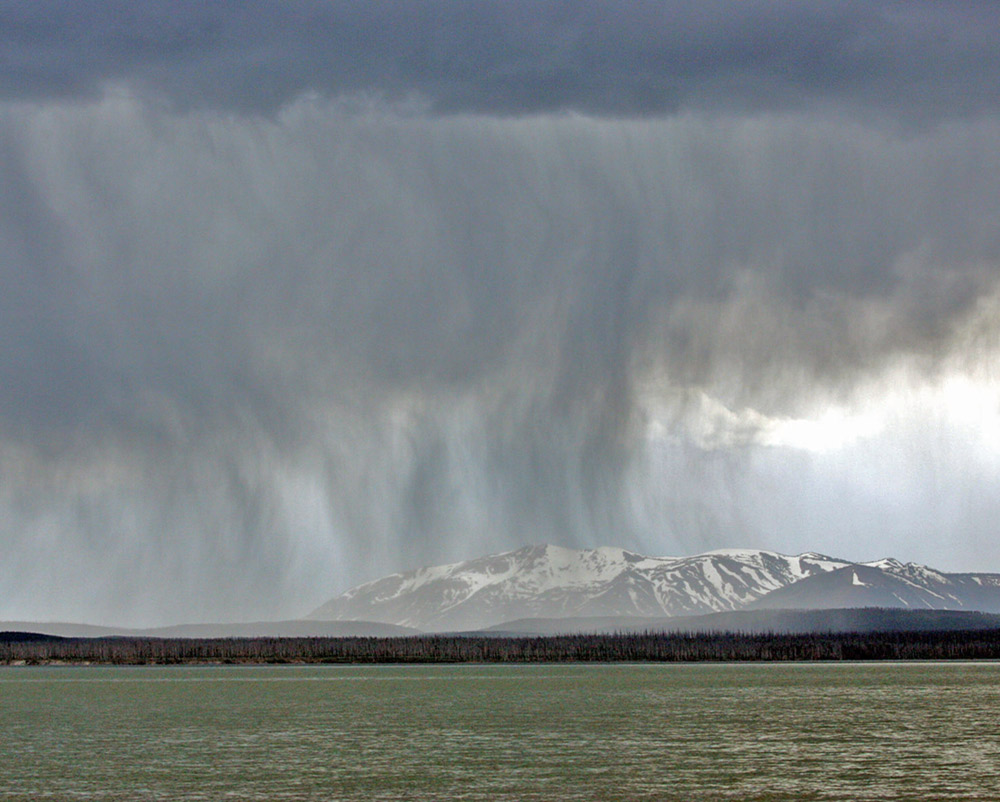 The air is full of water, even if you can't see it. Higher in the sky where it is colder than at the land surface, invisible water vapor condenses into tiny liquid water droplets—clouds. When the cloud droplets combine to form heavier cloud drops, it can start to rain, snow, hail....all forms of precipitation.
The air is full of water, even if you can't see it. Higher in the sky where it is colder than at the land surface, invisible water vapor condenses into tiny liquid water droplets—clouds. When the cloud droplets combine to form heavier cloud drops, it can start to rain, snow, hail....all forms of precipitation.
The amount of precipitation that falls is different all around the world. In deserts, such as in Chile, it may only rain one inch per year, while on some mountains in Hawaii and in India, it can rain more than 600 inches per year. That is almost 2 inches every day!
Precipitation is the "exit ramp" back to earth from the water-cycle superhighway in the sky that is moving clouds all around the globe.
Rivers
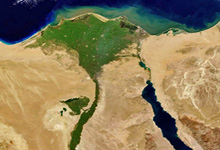 Most of the rain that falls stays on the land surface and, due to gravity, starts running downhill. This runoff water will accumulate in creeks ... I mean, in streams ...no, I mean, in rivers. Actually, no matter what you call them, rivers are responsible for moving a lot of water off of the land and back into oceans.
Most of the rain that falls stays on the land surface and, due to gravity, starts running downhill. This runoff water will accumulate in creeks ... I mean, in streams ...no, I mean, in rivers. Actually, no matter what you call them, rivers are responsible for moving a lot of water off of the land and back into oceans.
Of course, plants, animals, and people interact with rivers, as all kinds of life seems to thrive around rivers. If you look at a map of the world, you see how people naturally build their cities next to rivers.
And, as this satellite picture of the Nile River in Egypt, you can often pick out the rivers because of the green growth growing along them.
Runoff
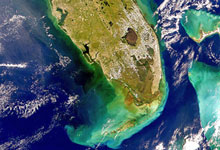 Runoff is nothing more than water "running off" the land surface. Just as the water you wash your car with runs off down the driveway as you work, the rain that Mother Nature covers the landscape with runs off downhill, too (due to gravity, of course).
Runoff is nothing more than water "running off" the land surface. Just as the water you wash your car with runs off down the driveway as you work, the rain that Mother Nature covers the landscape with runs off downhill, too (due to gravity, of course).
Even though some rainfall soaks into the ground, most of it flows over the land surface, going downhill. This runoff water reaches creeks, rivers, lakes, and the oceans, keeping the water cycle going.
Seepage
 You know all about seepage. When you spill your red fruit drink onto your Mom's white carpet, she rushes (after glaring at you) to get a sponge to soak up the liquid before it "seeps down into the carpet".
You know all about seepage. When you spill your red fruit drink onto your Mom's white carpet, she rushes (after glaring at you) to get a sponge to soak up the liquid before it "seeps down into the carpet".
With the water cycle, seepage occurs when precipitation falls on the landscape and starts to soak into the ground. The "Why?" this happens is simply gravity. But, seepage doesn't just happen downward! Water seeps upwards and sideways, too, from the ground into the bottom of rivers, lakes, and the oceans. Some of the water you see flowing in a river has come up from the ground.
Snowmelt
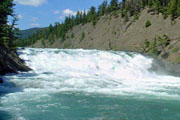 When it rains, the rivers rise, right? But what about when it snows–what happens then? Yes, the rivers still rise, but it may not happen until months after it has snowed. In many places, the snow builds up all winter and does not begin to melt until spring.
When it rains, the rivers rise, right? But what about when it snows–what happens then? Yes, the rivers still rise, but it may not happen until months after it has snowed. In many places, the snow builds up all winter and does not begin to melt until spring.
Just like the flowers waiting for springtime to bloom, this snow is waiting for warmer temperatures so it can melt and get back into the ever-moving water cycle. If a lot of snowmelt happens in the spring, watch out downstream, because flooding can occur from the melting of months of accumulated snow.
The Sun
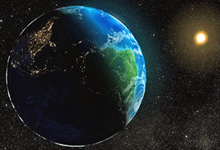 Who's the Boss? The sun is the real boss of the water cycle, and it doesn't even live here on Earth. The sun is what makes the water cycle work. The sun provides what almost everything on Earth needs to go—energy, or heat.
Who's the Boss? The sun is the real boss of the water cycle, and it doesn't even live here on Earth. The sun is what makes the water cycle work. The sun provides what almost everything on Earth needs to go—energy, or heat.
The sun's heat allows liquid water to evaporate into water vapor, which in the main way water gets from the land surface back into the sky.
The sun also participates in moving water around the Earth by being the reason winds exist. The winds move clouds and the weather all over the place; all of this mixing up and moving is an important part of the water cycle.
Evapotranspiration (Evaporation and transpiration)
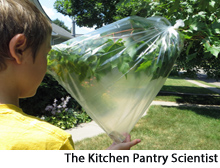 When a person breathes, their breath contains water molecules. All the plants around you are "breathing" and releasing water, too. The term is called "transpiration", and although a brussels sprout doesn't have a mouth, it has tiny holes in its leaves that allow water to leave the leaf, via evaporation, and go into the air.
When a person breathes, their breath contains water molecules. All the plants around you are "breathing" and releasing water, too. The term is called "transpiration", and although a brussels sprout doesn't have a mouth, it has tiny holes in its leaves that allow water to leave the leaf, via evaporation, and go into the air.
Our newest water cycle diagram depicts the global water cycle, as well as how human water use affects where water is stored, how it moves, and how clean it is. Check it out here! https://labs.waterdata.usgs.gov/visualizations/water-cycle/index.html#/


